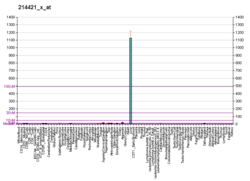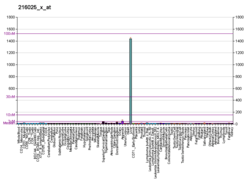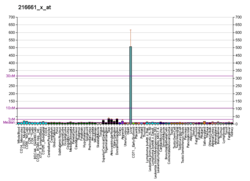CYP2C9
Cytochrome P450 2C9 (abbreviated CYP2C9) is an enzyme that in humans is encoded by the CYP2C9 gene.[3][4]
Function
CYP2C9 is an important cytochrome P450 enzyme with a major role in the oxidation of both xenobiotic and endogenous compounds. CYP2C9 makes up about 18% of the cytochrome P450 protein in liver microsomes (data only for antifungal). Some 100 therapeutic drugs are metabolized by CYP2C9, including drugs with a narrow therapeutic index such as warfarin and phenytoin and other routinely prescribed drugs such as acenocoumarol, tolbutamide, losartan, glipizide, and some nonsteroidal anti-inflammatory drugs. By contrast, the known extrahepatic CYP2C9 often metabolizes important endogenous compound such as serotonin and, owing to its epoxygenase activity, various polyunsaturated fatty acids, converting these fatty acids to a wide range of biological active products.[5][6]
In particular, CYP2C9 metabolizes arachidonic acid to the following eicosatrienoic acid epoxide (termed EETs) stereoisomer sets: 5R,6S-epoxy-8Z,11Z,14Z-eicosatetrienoic and 5S,6R-epoxy-8Z,11Z,14Z-eicosatetrienoic acids; 11R,12S-epoxy-8Z,11Z,14Z-eicosatetrienoic and 11S,12R-epoxy-5Z,8Z,14Z-eicosatetrienoic acids; and 14R,15S-epoxy-5Z,8Z,11Z-eicosatetrainoic and 14S,15R-epoxy-5Z,8Z,11Z-eicosatetrainoic acids. It likewise metablizes docosahexaenoic acid to epoxydocosapentaenoic acids (EDPs; primarily 19,20-epoxy-eicosapentaenoic acid isomers [i.e. 10,11-EDPs]) and eicosapentaenoic acid to epoxyeicosatetraenoic acids (EEQs, primarily 17,18-EEQ and 14,15-EEQ isomers).[7] Animal model and a limited number of human studies implicate these epoxides in reducing hypertension; protecting against the Myocardial infarction and other insults to the heart; promoting the growth and metastasis of certain cancers; inhibiting inflammation; stimulating blood vessel formation; and possessing a variety of actions on neural tissues including modulating Neurohormone release and blocking pain perception (see epoxyeicosatrienoic acid and epoxygenase pages).[6]
In vitro studies on human and animal cells and tissues and in vivo animal model studies indicate that certain EDPs and EEQs (16,17-EDPs, 19,20-EDPs, 17,18-EEQs have been most often examined) have actions which often oppose those of another product of CYP450 enzymes (e.g. CYP4A1, CYP4A11, CYP4F2, CYP4F3A, and CYP4F3B) viz., 20-Hydroxyeicosatetraenoic acid (20-HETE), principally in the areas of blood pressure regulation, blood vessel thrombosis, and cancer growth (see 20-Hydroxyeicosatetraenoic acid, Epoxyeicosatetraenoic acid, and Epoxydocosapentaenoic acid sections on activities and clinical significance). Such studies also indicate that the EPAs and EEQs are: 1) more potent than EETs in decreasing hypertension and pain perception; 2) more potent than or equal in potency to the EETs in suppressing inflammation; and 3) act oppositely from the EETs in that they inhibit angiogenesis, endothelial cell migration, endothelial cell proliferation, and the growth and metastasis of human breast and prostate cancer cell lines whereas EETs have stimulatory effects in each of these systems.[8][9][10][11] Consumption of omega-3 fatty acid-rich diets dramatically raises the serum and tissue levels of EDPs and EEQs in animals as well as humans and in humans are by far the most prominent change in the profile of PUFA metabolites caused by dietary omega-3 fatty acids.[8][11][12]
CYP2C9 may also metabolize linoleic acid to the potentially very toxic products, vernolic acid (also termed leukotoxin) and coronaric acid (also termed isoleukotoxin); these linoleic acid eoxides cause multiple organ failure and acute respiratory distress in animal models and may contribute to these syndromes in humans.[6]
Pharmacogenomics
Genetic polymorphism exists for CYP2C9 expression because the CYP2C9 gene is highly polymorphic. More than 50 single nucleotide polymorphisms (SNPs) have been described in the regulatory and coding regions of the CYP2C9 gene,[13] some of them are associated with reduced enzyme activity compared with wild type in vitro.
Multiple in vivo studies also show that several mutant CYP2C9 genotypes are associated with significant reduction of in metabolism and daily dose requirements of selected CYP2C9 substrate. In fact, adverse drug reactions (ADRs) often result from unanticipated changes in CYP2C9 enzyme activity secondary to genetic polymorphisms. Especially for CYP2C9 substrates such as warfarin and phenytoin, diminished metabolic capacity because of genetic polymorphisms or drug-drug interactions can lead to toxicity at normal therapeutic doses.[14][15]
Allele frequencies(%) of CYP2C9 polymorphism
| African-American | Black-African | Pygmy | Asian | Caucasian | |
|---|---|---|---|---|---|
| CYP2C9*2 | 2.9 | 0-4.3 | 0 | 0-0.1 | 8-19 |
| CYP2C9*3 | 2.0 | 0-2.3 | 0 | 1.1-3.6 | 3.3-16.2 |
| CYP2C9*5 | 0-1.7 | 0.8-1.8 | ND | 0 | 0 |
| CYP2C9*6 | 0.6 | 2.7 | ND | 0 | 0 |
| CYP2C9*7 | 0 | 0 | 6 | 0 | 0 |
| CYP2C9*8 | 1.9 | 8.6 | 4 | 0 | 0 |
| CYP2C9*9 | 13 | 15.7 | 22 | 0 | 0.3 |
| CYP2C9*11 | 1.4-1.8 | 2.7 | 6 | 0 | 0.4-1.0 |
| CYP2C9*13 | ND | ND | ND | 0.19-0.45 | ND |
CYP2C9 Ligands
Most inhibitors of CYP2C9 are competitive inhibitors. Noncompetitive inhibitors of CYP2C9 include nifedipine,[16][17] phenethyl isothiocyanate,[18] medroxyprogesterone acetate[19] and 6-hydroxyflavone. It was indicated that the noncompetitive binding site of 6-hydroxyflavone is the reported allosteric binding site of the CYP2C9 enzyme.[20]
Following is a table of selected substrates, inducers and inhibitors of CYP2C9. Where classes of agents are listed, there may be exceptions within the class.
Inhibitors of CYP2C9 can be classified by their potency, such as:
- Strong being one that causes at least a 5-fold increase in the plasma AUC values, or more than 80% decrease in clearance.[21]
- Moderate being one that causes at least a 2-fold increase in the plasma AUC values, or 50-80% decrease in clearance.[21]
- Weak being one that causes at least a 1.25-fold but less than 2-fold increase in the plasma AUC values, or 20-50% decrease in clearance.[21][22]
| Substrates | Inhibitors | Inducers |
|---|---|---|
|
Strong
Moderate Unspecified potency
|
Strong Weak |
Epoxygenase activity
CYP2C9 attacks various long-chain polyunsaturated fatty acids at their double (i.e. alkene) bonds to form epoxide products that act as signaling molecules. It along with CYP2C8, CYP2C19, CYP2J2, and possibly CYP2S1 are the principle enzymes which metabolizes 1) arachidonic acid to various epoxyeicosatrienoic acids (also termed EETs); 2) linoleic acid to 9,10-epoxy octadecaenoic acids (also termed vernolic acid, linoleic acid 9:10-oxide, or leukotoxin) and 12,13-epoxy-octadecaenoic (also termed coronaric acid, linoleic acid 12,13-oxide, or isoleukotoxin); 3) docosohexaenoic acid to various epoxydocosapentaenoic acids (also termed EDPs); and 4) eicosapentaenoic acid to various epoxyeicosatetraenoic acids (also termed EEQs).[6] Animal model studies implicate these epoxides in regulating: hypertension, Myocardial infarction and other insults to the heart, the growth of various cancers, inflammation, blood vessel formation, and pain perception; limited studies suggest but have not proven that these epoxides may function similarly in humans (see epoxyeicosatrienoic acid and epoxygenase pages).[6] Since the consumption of omega-3 fatty acid-rich diets dramatically raises the serum and tissue levels of the EDP and EEQ metabolites of the omega-3 fatty acid, i.e. docosahexaenoic and eicosapentaenoic acids, in animals and humans and in humans is the most prominent change in the profile of PUFA metabolites caused by dietary omega-3 fatty acids, EPA and EEQs may be responsible for at least some of the beneficial effects ascribed to dietary omega-3 fatty acids.[33][34][35]
See also
References
- ↑ "Human PubMed Reference:".
- ↑ "Mouse PubMed Reference:".
- ↑ Romkes M, Faletto MB, Blaisdell JA, Raucy JL, Goldstein JA (April 1991). "Cloning and expression of complementary DNAs for multiple members of the human cytochrome P450IIC subfamily". Biochemistry. 30 (13): 3247–55. PMID 2009263. doi:10.1021/bi00227a012.
- ↑ Inoue K, Inazawa J, Suzuki Y, Shimada T, Yamazaki H, Guengerich FP, Abe T (September 1994). "Fluorescence in situ hybridization analysis of chromosomal localization of three human cytochrome P450 2C genes (CYP2C8, 2C9, and 2C10) at 10q24.1". The Japanese Journal of Human Genetics. 39 (3): 337–43. PMID 7841444. doi:10.1007/BF01874052.
- ↑ Rettie AE, Jones JP (2005). "Clinical and toxicological relevance of CYP2C9: drug-drug interactions and pharmacogenetics". Annual Review of Pharmacology and Toxicology. 45: 477–94. PMID 15822186. doi:10.1146/annurev.pharmtox.45.120403.095821.
- 1 2 3 4 5 Spector AA, Kim HY (April 2015). "Cytochrome P450 epoxygenase pathway of polyunsaturated fatty acid metabolism". Biochimica et Biophysica Acta. 1851 (4): 356–65. PMC 4314516
 . PMID 25093613. doi:10.1016/j.bbalip.2014.07.020.
. PMID 25093613. doi:10.1016/j.bbalip.2014.07.020. - ↑ Westphal C, Konkel A, Schunck WH (November 2011). "CYP-eicosanoids--a new link between omega-3 fatty acids and cardiac disease?". Prostaglandins & Other Lipid Mediators. 96 (1-4): 99–108. PMID 21945326. doi:10.1016/j.prostaglandins.2011.09.001.
- 1 2 Fleming I (October 2014). "The pharmacology of the cytochrome P450 epoxygenase/soluble epoxide hydrolase axis in the vasculature and cardiovascular disease". Pharmacological Reviews. 66 (4): 1106–40. PMID 25244930. doi:10.1124/pr.113.007781.
- ↑ Zhang G, Kodani S, Hammock BD (Jan 2014). "Stabilized epoxygenated fatty acids regulate inflammation, pain, angiogenesis and cancer". Progress in Lipid Research. 53: 108–23. PMC 3914417
 . PMID 24345640. doi:10.1016/j.plipres.2013.11.003.
. PMID 24345640. doi:10.1016/j.plipres.2013.11.003. - ↑ He J, Wang C, Zhu Y, Ai D (December 2015). "Soluble epoxide hydrolase: A potential target for metabolic diseases". Journal of Diabetes. 8: 305–13. PMID 26621325. doi:10.1111/1753-0407.12358.
- 1 2 Wagner K, Vito S, Inceoglu B, Hammock BD (October 2014). "The role of long chain fatty acids and their epoxide metabolites in nociceptive signaling". Prostaglandins & Other Lipid Mediators. 113-115: 2–12. PMC 4254344
 . PMID 25240260. doi:10.1016/j.prostaglandins.2014.09.001.
. PMID 25240260. doi:10.1016/j.prostaglandins.2014.09.001. - ↑ Fischer R, Konkel A, Mehling H, Blossey K, Gapelyuk A, Wessel N, von Schacky C, Dechend R, Muller DN, Rothe M, Luft FC, Weylandt K, Schunck WH (March 2014). "Dietary omega-3 fatty acids modulate the eicosanoid profile in man primarily via the CYP-epoxygenase pathway". Journal of Lipid Research. 55 (6): 1150–1164. PMC 4031946
 . PMID 24634501. doi:10.1194/jlr.M047357.
. PMID 24634501. doi:10.1194/jlr.M047357. - ↑ Sim, Sarah C (2 May 2011). "CYP2C9 allele nomenclature". Cytochrome P450 (CYP) Allele Nomenclature Committee.
- ↑ García-Martín E, Martínez C, Ladero JM, Agúndez JA (2006). "Interethnic and intraethnic variability of CYP2C8 and CYP2C9 polymorphisms in healthy individuals". Molecular Diagnosis & Therapy. 10 (1): 29–40. PMID 16646575. doi:10.1007/BF03256440.
- ↑ Rosemary J, Adithan C (Jan 2007). "The pharmacogenetics of CYP2C9 and CYP2C19: ethnic variation and clinical significance". Current Clinical Pharmacology. 2 (1): 93–109. PMID 18690857. doi:10.2174/157488407779422302.
- ↑ Bourrié M, Meunier V, Berger Y, Fabre G (February 1999). "Role of cytochrome P-4502C9 in irbesartan oxidation by human liver microsomes". Drug Metabolism and Disposition. 27 (2): 288–96. PMID 9929518.
- ↑ Salsali M, Holt A, Baker GB (February 2004). "Inhibitory effects of the monoamine oxidase inhibitor tranylcypromine on the cytochrome P450 enzymes CYP2C19, CYP2C9, and CYP2D6". Cellular and Molecular Neurobiology. 24 (1): 63–76. PMID 15049511. doi:10.1023/B:CEMN.0000012725.31108.4a.
- ↑ Nakajima M, Yoshida R, Shimada N, Yamazaki H, Yokoi T (August 2001). "Inhibition and inactivation of human cytochrome P450 isoforms by phenethyl isothiocyanate". Drug Metabolism and Disposition. 29 (8): 1110–3. PMID 11454729.
- ↑ Zhang JW, Liu Y, Li W, Hao DC, Yang L (July 2006). "Inhibitory effect of medroxyprogesterone acetate on human liver cytochrome P450 enzymes". European Journal of Clinical Pharmacology. 62 (7): 497–502. PMID 16645869. doi:10.1007/s00228-006-0128-9.
- 1 2 3 4 5 Si D, Wang Y, Zhou YH, Guo Y, Wang J, Zhou H, Li ZS, Fawcett JP (March 2009). "Mechanism of CYP2C9 inhibition by flavones and flavonols". Drug Metabolism and Disposition. 37 (3): 629–34. PMID 19074529. doi:10.1124/dmd.108.023416.
- 1 2 3 4 5 6 7 8 9 10 11 12 13 14 15 16 17 18 19 20 21 22 23 24 25 26 27 28 29 30 31 32 33 34 35 36 37 38 39 40 41 42 43 44 Flockhart DA (2007). "Drug Interactions: Cytochrome P450 Drug Interaction Table". Indiana University School of Medicine.
- 1 2 3 4 5 "Drug Development and Drug Interactions: Table of Substrates, Inhibitors and Inducers". U.S. Food and Drug Administration. U.S. Food and Drug Administration. Retrieved 13 March 2016.
- 1 2 3 4 5 6 7 8 9 10 11 12 13 14 15 16 17 18 19 20 21 FASS (drug formulary): "Facts for prescribers (Fakta för förskrivare)". Swedish environmental classification of pharmaceuticals (in Swedish).
- ↑ Guo Y, Zhang Y, Wang Y, Chen X, Si D, Zhong D, Fawcett JP, Zhou H (June 2005). "Role of CYP2C9 and its variants (CYP2C9*3 and CYP2C9*13) in the metabolism of lornoxicam in humans". Drug Metabolism and Disposition. 33 (6): 749–53. PMID 15764711. doi:10.1124/dmd.105.003616.
- ↑ "ketoprofen | C16H14O3". PubChem.
- ↑ Stout SM, Cimino NM (February 2014). "Exogenous cannabinoids as substrates, inhibitors, and inducers of human drug metabolizing enzymes: a systematic review". Drug Metabolism Reviews. 46 (1): 86–95. PMID 24160757. doi:10.3109/03602532.2013.849268.
- ↑ Miyazawa M, Shindo M, Shimada T (May 2002). "Metabolism of (+)- and (-)-limonenes to respective carveols and perillyl alcohols by CYP2C9 and CYP2C19 in human liver microsomes". Drug Metabolism and Disposition. 30 (5): 602–7. PMID 11950794. doi:10.1124/dmd.30.5.602.
- ↑ Kimura Y, Ito H, Ohnishi R, Hatano T (Jan 2010). "Inhibitory effects of polyphenols on human cytochrome P450 3A4 and 2C9 activity". Food and Chemical Toxicology. 48 (1): 429–35. PMID 19883715. doi:10.1016/j.fct.2009.10.041.
- ↑ Pan X, Tan N, Zeng G, Zhang Y, Jia R (October 2005). "Amentoflavone and its derivatives as novel natural inhibitors of human Cathepsin B". Bioorganic & Medicinal Chemistry. 13 (20): 5819–25. PMID 16084098. doi:10.1016/j.bmc.2005.05.071.
- 1 2 He N, Zhang WQ, Shockley D, Edeki T (February 2002). "Inhibitory effects of H1-antihistamines on CYP2D6- and CYP2C9-mediated drug metabolic reactions in human liver microsomes". European Journal of Clinical Pharmacology. 57 (12): 847–51. PMID 11936702. doi:10.1007/s00228-001-0399-0.
- ↑ Park JY, Kim KA, Kim SL (November 2003). "Chloramphenicol is a potent inhibitor of cytochrome P450 isoforms CYP2C19 and CYP3A4 in human liver microsomes". Antimicrobial Agents and Chemotherapy. 47 (11): 3464–9. PMC 253795
 . PMID 14576103. doi:10.1128/AAC.47.11.3464-3469.2003.
. PMID 14576103. doi:10.1128/AAC.47.11.3464-3469.2003. - ↑ Robertson P, DeCory HH, Madan A, Parkinson A (June 2000). "In vitro inhibition and induction of human hepatic cytochrome P450 enzymes by modafinil". Drug Metabolism and Disposition. 28 (6): 664–71. PMID 10820139.
- ↑ "The pharmacology of the cytochrome P450 epoxygenase/soluble epoxide hydrolase axis in the vasculature and cardiovascular disease". Pharmacol. Rev. 66: 1106–40. 2014. PMID 25244930. doi:10.1124/pr.113.007781.
- ↑ "The role of long chain fatty acids and their epoxide metabolites in nociceptive signaling". Prostaglandins Other Lipid Mediat. 113-115: 2–12. 2014. PMC 4254344
 . PMID 25240260. doi:10.1016/j.prostaglandins.2014.09.001.
. PMID 25240260. doi:10.1016/j.prostaglandins.2014.09.001. - ↑ "Dietary omega-3 fatty acids modulate the eicosanoid profile in man primarily via the CYP-epoxygenase pathway". J. Lipid Res. 55: 1150–1164. 2014. PMC 4031946
 . PMID 24634501. doi:10.1194/jlr.M047357.
. PMID 24634501. doi:10.1194/jlr.M047357.
Further reading
- Goldstein JA, de Morais SM (December 1994). "Biochemistry and molecular biology of the human CYP2C subfamily". Pharmacogenetics. 4 (6): 285–99. PMID 7704034. doi:10.1097/00008571-199412000-00001.
- Miners JO, Birkett DJ (June 1998). "Cytochrome P4502C9: an enzyme of major importance in human drug metabolism". British Journal of Clinical Pharmacology. 45 (6): 525–38. PMC 1873650
 . PMID 9663807. doi:10.1046/j.1365-2125.1998.00721.x.
. PMID 9663807. doi:10.1046/j.1365-2125.1998.00721.x. - Smith G, Stubbins MJ, Harries LW, Wolf CR (December 1998). "Molecular genetics of the human cytochrome P450 monooxygenase superfamily". Xenobiotica. 28 (12): 1129–65. PMID 9890157. doi:10.1080/004982598238868.
- Henderson RF (June 2001). "Species differences in the metabolism of olefins: implications for risk assessment". Chemico-Biological Interactions. 135-136: 53–64. PMID 11397381. doi:10.1016/S0009-2797(01)00170-3.
- Xie HG, Prasad HC, Kim RB, Stein CM (November 2002). "CYP2C9 allelic variants: ethnic distribution and functional significance". Advanced Drug Delivery Reviews. 54 (10): 1257–70. PMID 12406644. doi:10.1016/S0169-409X(02)00076-5.
- Palkimas MP, Skinner HM, Gandhi PJ, Gardner AJ (June 2003). "Polymorphism induced sensitivity to warfarin: a review of the literature". Journal of Thrombosis and Thrombolysis. 15 (3): 205–12. PMID 14739630. doi:10.1023/B:THRO.0000011376.12309.af.
- Daly AK, Aithal GP (August 2003). "Genetic regulation of warfarin metabolism and response". Seminars in Vascular Medicine. 3 (3): 231–8. PMID 15199455. doi:10.1055/s-2003-44458.
External links
- PharmGKB: Annotated PGx Gene Information for CYP2C9
- SuperCYP: Database for Drug-Cytochrome-Interactions
- Human CYP2C9 genome location and CYP2C9 gene details page in the UCSC Genome Browser.






